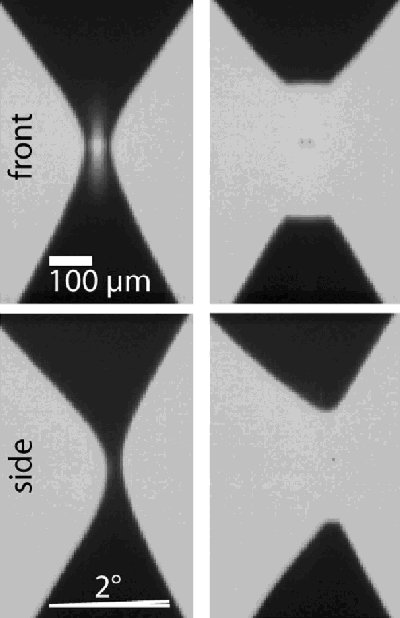Physicists at the University of Chicago have discovered that air bubbles retain a "memory" of how they are formed (Phys Rev Lett 97 144503). Their study revealed that the initial conditions of bubble formation can affect the dynamics of the singularity that occurs when a bubble pinches off a nozzle. This could have profound implications for our understanding of other phenomena that involve singularities including the formation of black holes or supernovae.

A singularity occurs when one or more of the physical parameters in a system approaches infinity. In bubble formation, this occurs at the moment of pinch-off, when the stress and pressure become very large. Physicists had thought that this pinch-off would always occur in a highly symmetric manner, regardless of the initial conditions of bubble formation.
But now the Chicago research group led by Sidney Nagel has used high-speed photography to reveal that the physical appearance of the singularity is influenced by the shape, size and angle of tilt of the nozzle.
The group used a syringe to release air quasistatically (i.e. very slowly) through nozzles between 1.5 and 4.1 mm in diameter. A digital camera photographed the resulting bubbles up to 130,000 times a second. The nozzles could also be tilted, effectively altering the shape of the aperture, to see if an asymmetric formation had any affect on the dynamics near the singularity.
By measuring the radius of the neck of air joining the nozzle to the bubble as a function of time, they found that the neck collapsed so rapidly (following a power law) while approaching the singularity that surface tension could not erase any asymmetry present from the outset. Varying the tilt confirmed that the asymmetry was not erased: for small angles of less than a degree the neck branched out into “satellite” bubbles, and the pinch-off was shifted laterally away from the direction of tilt. At two degrees, the satellite bubbles moved upwards and away from the direction of tilt, indicating an asymmetry in fluid velocities.
Chicago researcher Nathan Keim told PhysicsWeb that this asymmetry is a “memory” of the initial conditions of formation. He believes that this phenomena may not be limited to air bubbles and that other singularities such as black-hole formation could involve the retention of some aspects of the initial conditions. “In that way, the question of what a singularity can remember goes far beyond our table-top experiment,” explained Keim.




